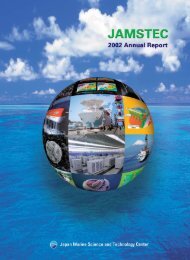2007 Annual Report - jamstec japan agency for marine-earth ...
2007 Annual Report - jamstec japan agency for marine-earth ...
2007 Annual Report - jamstec japan agency for marine-earth ...
You also want an ePaper? Increase the reach of your titles
YUMPU automatically turns print PDFs into web optimized ePapers that Google loves.
polar lipids and DNA from sediment samples from various<br />
parts of the world, including core samples to a depth of 365m<br />
below the sea bottom taken off Shimokita, Japan by the deepsea<br />
drilling vessel Chikyu in 2006, and clarified the fact that<br />
many of the microbial living cells included in sea-bottom sediments<br />
are archaea (Lipp, Morono, Inagaki & Hinrichs, Nature,<br />
2008).<br />
Because archaea cells have a membrane structure with<br />
lower fluidity than bacteria, it is thought that they evolved by<br />
adapting to an environment with a low energy supply rate, that<br />
is, the environment provided by seafloor sediments.<br />
In research on the sub-seafloor biosphere, accurate detection<br />
of the cells in core sediment samples and evaluation of<br />
their quantities is extremely basic and important knowledge.<br />
However, in visual observation by fluorescence microscopy, it<br />
is difficult to distinguish between the fluorescence emitted by<br />
the cells and that emitted by the sedimentary material, and the<br />
limit concentration <strong>for</strong> detection is high due to the limitations of<br />
identification by the human eye and the amount observed.<br />
There<strong>for</strong>e, at the current point in time, it is not possible to carry<br />
out research exploring the limits of the sub-seafloor biosphere,<br />
targeting low biomass environments in future deep environments<br />
and high temperature environments. We developed a revolutionary<br />
new experimental system <strong>for</strong> accurately detecting<br />
and quantifying only living organisms (cells) containing DNA<br />
from the matrix of sedimentary materials by constructing a<br />
computerized automatic microscope control system and per<strong>for</strong>ming<br />
image analysis on the fluorescent spectrum of the fluorescence<br />
microscopy images obtained with that system<br />
(Morono, Terada, Masui & Inagaki, submitted to Nature<br />
Methods). Using the newly-developed technique and microscope<br />
system, the quantity of microbial cells contained in core<br />
samples of ODP Leg 201, which was the world's first subsurface<br />
biosphere drilling voyage, and cores taken off Shimokita<br />
were accurately evaluated based on objective digital data,<br />
reconfirming the existence of large quantities of microbial cells<br />
in deep sub-seafloor sediment samples.<br />
Researchers from the Geomicrobiology Group also sailed<br />
on the Stage 1 expedition (IODP Epx. 315, 316) in the Nankai<br />
Trough Seismogenic Zone Experiment (NanTroSEIZE) and<br />
directly took core samples at multiple drilling locations, including<br />
a mega-splay fault and a fault zone at the leading edge<br />
(frontal thrust) of an accretionary prism. These samples are<br />
being stored in a cryogenic environment in a freezer or in an<br />
anaerobic refrigerator by this research group. Present work<br />
includes measurement of the biomass in Nankai trough drilling<br />
samples using the newly-developed automatic microscope system<br />
and analysis of the diversity of microorganisms using a<br />
first riser test of the Chikyu, which was conducted off<br />
Shimokita in 2006, this research group made an evaluation, by<br />
the culture method and molecular biology techniques, of the<br />
microbial phase in the circulation mud fluids be<strong>for</strong>e and after<br />
riser drilling. This research is only possible in the first trial.<br />
This study yielded important knowledge, including the fact that<br />
the current chemical composition of the mud fluids does not<br />
adequately control the multiplication of external microorganisms,<br />
and designated subsurface microorganisms multiplied in<br />
the mud fluid tank after circulation (Masui, Morono & Inagaki,<br />
Geomicrobiol. J. 2008). In the future, detailed studies will be<br />
carried out, including a further quality evaluation of microbial<br />
samples, development of an aseptic sampling method with<br />
frozen samples, and a quality evaluation using different storage<br />
methods.<br />
3 Core Sampler Curation System and Start of Full-Scale<br />
Operation of Facilities and Equipment<br />
The Kochi Institute began receiving of drilling cores <strong>for</strong><br />
the ocean areas <strong>for</strong> which Japan is responsible, as agreed by the<br />
IODP-SPC (Integrated Ocean Drilling Program-Science<br />
Planning Committee), and began preparations to receive core<br />
samples obtained by JAMSTEC's vessels, and other devices.<br />
During this fiscal year, legacy cores with a total length of<br />
approximately 84 km, which were taken by the Glomar<br />
Challenger and JOIDES (Joint Oceanographic Institutions <strong>for</strong><br />
Deep Earth Sampling) Resolution under the Deep Sea Drilling<br />
Project/Ocean Drilling Program (DSDP/ODP), and had been<br />
managed by storage facilities in the United States, were succesmetagenomic<br />
technique, etc. in order to determine what kinds<br />
of linkage may exist between the distribution and functions of<br />
microorganisms in sub-seafloor environments and the distinctive<br />
features of organisms accompanying geological activity.<br />
In the future, if the sub-seafloor biosphere is to be explored<br />
by large-depth drilling, evaluation of contamination in samples<br />
by external microorganisms accompanying riser drilling will be<br />
important. Taking advantage of the opportunity provided by the<br />
Photo Hydrated methane gas bubbles.
















